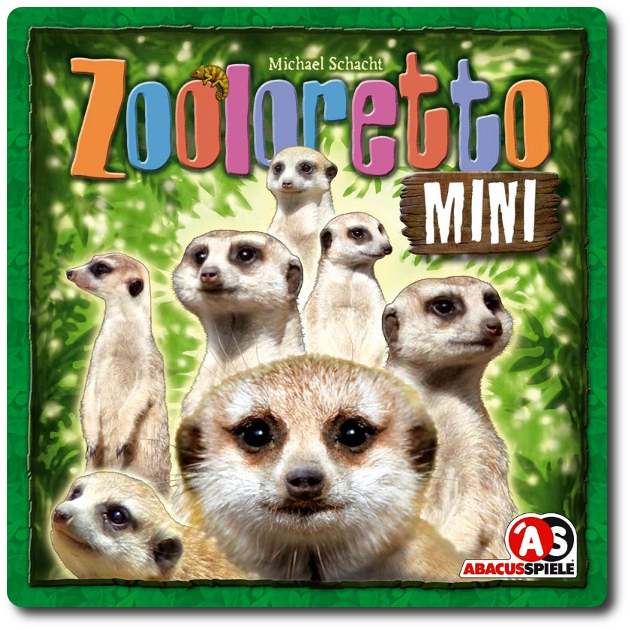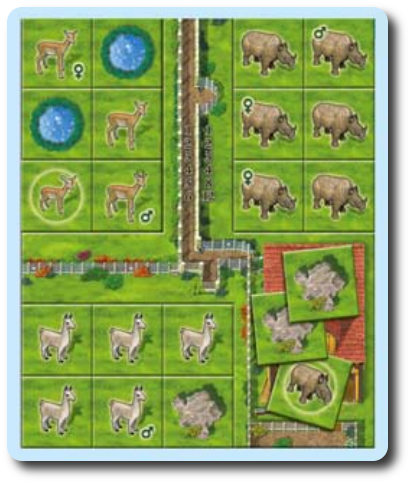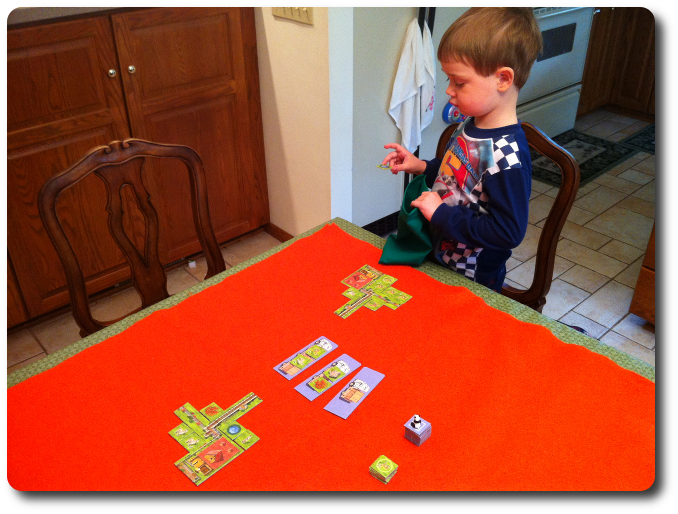
The Basics:
- For ages 4 and up (publisher suggests 7+)
- For 2 to 5 players
- About 30 minutes to complete
Geek Skills:
- Counting & Math
- Logical & Critical Decision Making
- Pattern Matching
- Risk vs. Reward
- Hand/Resource Management
Learning Curve:
- Child – Easy
- Adult – Easy
Theme & Narrative:
- Congratulations! You own your own zoo and must now fill it with animals, but careful planning is needed as you only have so much space!
Endorsements:
- Gamer Geek approved!
- Parent Geek approved!
- Child Geek approved!
Overview
Zooloretto Mini, by game designer Michael Schacht, is a tile placement game that challenges the players to organize and fill their zoo intelligently and to manage a certain amount of risk at the same time. The players will be swamped with new animals, freshly loaded on delivery trucks, and must know when they should or should not accept the animals for delivery. For those players who can manage their space, timing, and balance their risk versus reward, their zoo will be epic! For those who do not, well…looks like you have yourself one very sad and sorry petting zoo.
Zooloretto Mini is comprised of 77 Animal tiles, 14 Offspring (baby animal) tiles, 9 Landscape tiles, 5 Delivery Truck tiles, 1 cloth bag, 1 Panda miniature, and 5 zoo boards. All the components (except the bag and Panda miniature) are made of thick cardboard and well detailed. The zoo boards interlock like puzzle pieces (which is made up of 3 pieces in total) to create the player’s playing area, which is a very nice touch, as it allows for the box the game comes in to remain fairly small.
Note: Zooloretto Mini has been titled the “Little Brother” of the 2007 “Spiel des Jahres” (Game of the Year) award winner, Zooloretto. Zooloretto Mini has been designed to be a simpler, faster, and less “heavy” game, but without reducing any of the charm and challenge of building a zoo.
Game Set Up
To set up the game, first have each player construct their zoo board. This is done by each player grabbing 3 sections that interlock like puzzle pieces. Once created, the player will have 3 areas to build their zoo and 1 barn where extra pieces the player cannot be used are stored. Place any remaining zoo board sections aside for the duration of the game.

Example of how the zoo boards are constructed and the resulting 3 enclosures with barn
Now separate and organize all the Animal and Offspring tiles into different piles, each pile representing one of the animals. This is, by far, the most time intensive portion of the game set up, but can be made into a quick exercise by all the players helping out. Once all the tiles have been organized, a number of animal groups will be removed from the game depending on the number of players. Be sure to remove the Animal and matching Offspring tiles, setting them aside for the duration of the game.
Now place all the remaining Animal tiles (not the Offspring tiles) and the Landscape tiles into the cloth bag and mix them up. Randomly select 15 tiles and place, face down, into a stack near all the players. Place the Panda miniature next to this stack. Next, take the Offspring tiles and place them in a stack, face-up, next to the Panda miniature and face-down stack.
Depending on the number of players, a number of Delivery Truck tiles will be placed in the center of the playing area. Now select a starting player and begin!
The Joys of Zoo Ownership
The player’s only goal in the game is to collect animals and fill their zoo. Sound simple? It isn’t. Turns out that the animal delivery business is less than organized. Zoos can expect a strange mix of animals to be delivered, as well as aesthetically pleasing landscaping supplies to make the animal enclosures a more enjoyable place for the animals to live. The players will essentially place “orders” on the delivery trucks. Unfortunately, so are all the other players and the delivery trucks only make one stop. This means the players will not only need to carefully “order” the delivery trucks but also make certain to watch their cargo so as to not miss on an opportunity to complete their zoo. While it might sound that there is a lot to think about, the game is simplified and streamlined by reducing the player’s turn to only two specific actions.
On a player’s turn, they can complete only one of the following:
- Add a Tile to a Delivery Truck
- Take a Delivery Truck
Add a Tile to a Delivery Truck
The player is “ordering” either an animal or landscaping supplies for their zoo. This is done by the player randomly (and blindly) selecting one tile from the cloth bag and place it on one of the Delivery Truck tiles. Delivery trucks have a maximum load capacity and can fill up quickly. The player can only place a tile on a free place on the delivery truck. If the Delivery Truck tile doesn’t have an open space, it is full and cannot be overloaded. This also means that players cannot add a tile to a delivery truck if all the Delivery Truck tiles are full, forcing them to take a delivery truck.
Note that a delivery truck can carry any combination of Animal and Landscape tiles.
Take a Delivery Truck
The player is ready to call in the order and sends word that a delivery truck should be dispatched. This is done by the player taking a Delivery Truck tile during their turn; however, their turn ends for the duration of the round once they do so. This means that taking a Delivery Truck tile will lock the player out from taking any other Delivery Truck or adding tiles until all the players have selected a Delivery Truck tile, too. Note that a player need not take a full Delivery Truck tile, but it must have at least one tile on it.
Once a Delivery Truck tile is selected, it is placed in front of the player, along with the tiles that delivery truck is holding. These tiles are now going to be placed in the player’s barn or one of their three zoo enclosures. The player must place these tile immediately.
To being the next round, return the Delivery Truck tiles to the center of the playing area, but only after all the player’s have selected a Delivery Truck tile.
Filling the Zoo
Once the player has tiles to add to their zoo, they have an important decision to make. Each of the 3 enclosures is only big enough for 6 tiles, which can be a mix of Animal and Landscape tiles. Each enclosure can only contain one type of animal, too. Mixing of animals in the same enclosure is strictly prohibited! The means the player must think about what animals they want to collect and where to put them. Once they know what they need, this will make the loading and selecting of delivery trucks easier.
Any tiles not capable of being placed in a player’s enclosure or any tiles the player chooses to not place in their enclosure are sent to the player’s barn. Here the tiles will stay and will count against the player’s final points.
Romance and Miracles
If a player should ever have a pair of fertile animals in the same enclosure (indicated with a male and female symbol on the tiles), the player is awarded with a little animal bundle of joy. The Offspring tile that matches the animal type is found in the Offspring stack and immediately placed in the enclosure. If the Offspring tile cannot be placed in the enclosure, it is placed in the barn. Note that a matched pair can only produce an Offspring once. The male and female animal cannot be used to match a new animal in the enclosure of the opposite sex.
The Rewards of Having Your Act Together
Once a player completes an enclosure, they immediately get to take a bonus turn. On this turn, they can take one of the following actions immediately. Note that the player must take this bonus turn now (they can’t bank it for later) and they get a maximum of 3 (one per completed enclosure, at most).
- Take an Opponent’s Tile: the player takes any tile from one of their opponent’s barns and places it in their enclosure. Note that if another enclosure is completed by this action, the player does not get a second bonus action!
- Discard a Tile: the player takes any single tile from their barn and removes it for the duration of the game.
End Game
Once the bag no longer has any tiles remaining in it, the end game is triggered. The only tiles left to select are the stack of tiles that the Panda mini is guarding. Players take their turn as normal, with their turn ending once they select a Delivery Truck tile. Once all the players have selected a delivery truck and placed any tiles on it, the game is over.
Winning the Game
When the game ends, the players calculate their points. First, the player calculates their positive points. Each enclosure will score a number of points based on the number of Animal and Landscape tiles. The player then calculates their negative points, which is based on the number of Animal and Landscape tiles located in the player’s barn.

Example of a player’s zoo board that is completed and ready for scoring
Once both point values are calculated, any negative points are subtracted from the positive points. The resulting value is the player’s total points. The player with the highest total points wins the game!
To learn more about Zooloretto Mini, see the game’s official web site. The Animal tiles from this game can be added to and played with Zooloretto.
Prediction
Zooloretto Mini has several things going for it right out of the gate for all three test groups. First, for the Gamer Geeks, there is a real “game” here that requires strategy and tactics, timing and taking risk. There is no luck element here, but there is randomness. This will keep them engaged and hooked, even though it is a less heavy game. Second, the Parent Geeks will have no problem playing this game with a wide age range and different experience levels. The game is simplistic enough to be grasped and challenging enough to not be a walk in the park (or zoo, if you will). Third, and most importantly, the Child Geeks get to use their creativity, design their own zoo, and make important and relevant choices but without feeling burdened.
Oh, yes, my friends, I can already tell we have a winner on our hands. It might also interest you to know that I have never played any of the Zooloretto games before. I heard of them and even had a chance to play a game or two, but for one reason or another, it never happened. I already instinctively knew the game was a good one just be reading the rules, mentally putting the game together in my mind, as I learned how the game played and flowed.
When I showed the game to my two oldest little geeks, they immediately were excited to play it, especially when I told them they were going to be making their own zoo. Games where the little geeks get to create something are some of their favorites. The feeling of accomplishment of making “something” always bring a smile to their faces. The promise of creating their own zoo brought such smiles now.
Zooloretto Mini is an easy game to play and an easy game to teach. Not an easy game to win. This fact was recognized by my 7-year-old when I explained that everything you put in the barn was going to count against them. In his words, “avoid the barn at all costs.” Good advice.
It only took a few minutes to explain how to play the game, give the little geeks some examples, and we were ready to play. As my little geeks helped me set up the gaming area, I asked them what they thought of the game so far.
“Looks really good. I like how we can make our own zoos and design the animal cages.” ~ Liam (age 7)
“Yeah, it’s a good game, Daddy. I’m going to make my zoo all rhinos!” ~ Nyhus (age 4)
Excitement and energy is in the air! Let’s see if the game taps into their creative side and is highly successful or ends up stinking like the pachyderm house on a hot summer day.
Final Word
Oh, the fun we had! All three groups had a wonderful time with Zooloretto Mini, but with slightly different degrees of success.
The Child Geeks loved the game. My 4-year-old was able to understand the game well enough to play the tiles correctly and did very well on the points. He took trucks from time to time that did little for him for scoring, but pleased him greatly when he was able to create a baby animal or complete an enclosure. My 7-year-old pretty much understood and mastered the basics of the game right out of the bat.
Parent Geeks also had a wonderful time with the game and were able to play it without issue with their family and non-gamer friends. Non-gamers found it to be a bit “hands on” at times (which made me laugh – we are talking about “building” a zoo here) but all agreed it was a fun game. Parent Geeks also found it to be an excellent “gateway game”, which means the game itself introduces new players to a different level of game playing in a manner that is both easy to understand and enjoyable. Think of it as a game that is the “next step” in your little geek’s gaming education.
Gamer Geeks agreed the game was a good one and found it to be a great way to start or end a gaming evening of heavier games. They all recognized the level of critical and logical thinking necessary to play the game well, and the lack of luck was happily accepted and applauded by all the Gamer Geeks who played it. One of the group members was a big Zooloretto fan and decided they actually liked this version of the game more due to its shorter set up time and more streamlined play.

My 4-year-old exams the tile he just draws before placing it on a delivery truck
Gamer Geeks, this is one of those games that is perfect for those times you want to play a game that isn’t heavy but still requires the players to think. The game is small but the choices that need to be made are important. Add in the fact that all the players are competing for the same resources, and there is suddenly a great deal of player watching and attempting to outmaneuver and out-guess your opponents. The end result is a delightful game that plays fast, provides gaming value, and leaves you with a feeling of satisfaction once completed.
Parent Geeks, this is a wonderful game to put on your family gaming table or to bring over to a friend’s house to play who might not be into heavier games. Little geeks as young as 4-year-old can play this game with very little assistance and the game itself is easy to teach regardless of the gaming experience at the table. The designing element of the zoo is straight forward and the ability to select different landscaping tiles for points ensures that every player’s enclosure will be unique. As an extra bonus, your little geeks might just go ga-ga over the baby animals as they are the most adorable animal tiles I have ever seen.
Little Geeks, now you can build your own zoo! This game is easy to learn and will challenge you, but your choices boil down to take a the tiles or place a tile. Building your zoo is easy, too, but be sure you can use as many of the tiles as possible! Do all you can to avoid putting anything in the barn, but don’t let a few animals or landscaping tiles in the barn slow you down, either. In the end, win or lose, you’ll be happy with your zoo and wish you could visit it yourself!
Zooloretto Mini was well received and is now well-loved. My 4-year-old and I play it often and the game plays just as well with 2-players as it does with 5-players. The lack of luck was a big win for the game and there is just the right amount of randomness to keep you guessing and hooked. Game play length was spot on and everything, from start to finish, was as smooth as a new baby hippos bottom. The only “snag” is the scoring which can be confusing for those who are playing for the first time. For this reason, I strongly suggest you make sure everyone at the table understands how the scoring is completed at the end of the game to avoid hurt feelings.
Challenging and rewarding without being heavy or difficult, Zooloretto Mini will be a fun game to play at your family table with little geeks, friends, and gamer elitists. Do play Zooloretto Mini the first chance you get!
This game was given to Father Geek as a review copy. Father Geek was not paid, bribed, wined, dined, or threatened in vain hopes of influencing this review. Such is the statuesque and legendary integrity of Father Geek.




Pingback: Zooligans Game Review (prepublished version) » Father Geek
Pingback: Zooleoretto | Wake Gifted Academy
Pingback: Dino Dude Ranch Game Review - Father Geek